Japan
Wood Products Prices
Dollar Exchange Rates of 25th
Aug
2021
Japan Yen 110.09
Reports From Japan
Corona update
In response to the resurgence in coronavirus infections the
Japanese government is adding eight prefectures,
including Aichi and Hiroshima, to the list of those under a
state of emergency. In a 25 August meeting the
Coronavirus Expert Advisory Board said the number of
new coronavirus cases has been "continuously exceeding
record-high levels for nearly a month," and reported
infections have been increasing at a higher rate in regions
outside the greater Tokyo area, compared to the capital
region. Japan's Cabinet has decided to use yen 1.4 trillion
(US$13 billion) of the fiscal 2021 reserve funds for
purchases of more vaccines as well as medicines.
Japan lags behind other developed economies in its
inoculation drive but aims to finish vaccinating all eligible
people in the nation who wish to receive shots sometime
between October and November.
The Japan Times has commented that this latest and worst
outbreak has highlighted the inability of the country¡¯s
highly regarded medical system to adapt quickly to
emergencies.
Quoting the Japan Times ¡°Japan¡¯s health care system has
an abundance of medical equipment and hospital beds and
near universal health care coverage. But it is built on the
strength of preventative and primary care at private
hospitals and cracks in its emergency care provision
resulting in a notorious ¡°death by delay¡±, a problem that
has existed for decades and has not been addressed.
See:
https://www.japantimes.co.jp/news/2021/08/26/national/japanhospitals-covid-19/
GDP growth
In the April-June period Japan's economy grew at an
annualised 1.3% supported by exports which compensated
for the weak domestic consumption, the result of the latest
surge in corona infections.
Cabinet Office data shows growth was better than the
average projection of 0.7% annualised growth forecast by
private-sector economists. The view among many
economists is that Japan is lagging behind other major
economies in its vaccine rollout which is holding back the
recovery.
In late August the Japanese government retained its view
on the domestic economy saying ¡°increased weakness has
been seen in some sectors¡± and warned of downside risks
from the recent resurgence of coronavirus infections.
The Cabinet Office said the economy shows "further"
weakness in some areas and remains in a severe situation
due to the pandemic. This coincided with the expanded
state of emergency to 21 out of Japan's 47 prefectures.
Looking ahead, the Cabinet Office report said the
economy is expected to continue picking up but warned
full attention should be given to a "further increase in
downside risks" due to the spread of the virus.
See:
https://mainichi.jp/english/articles/20210826/p2g/00m/0bu/034000c
Consumer prices continue down
The government announced that Japan¡¯s core consumer
prices, excluding volatile fresh food, dropped by 0.2% in
August from a year earlier marking 12 consecutive months
of decline underscoring and the challenge for the
government and Bank of Japan in their efforts to spur
inflation.
With booming demand in many advanced economies some
analysts have speculated that an inflation wave could
trickle down to Japan where the government has been
trying to break the cycle of deflation for a decade.
See:
https://www.japantimes.co.jp/news/2021/08/20/business/economy-business/japan-inflation-sluggish/
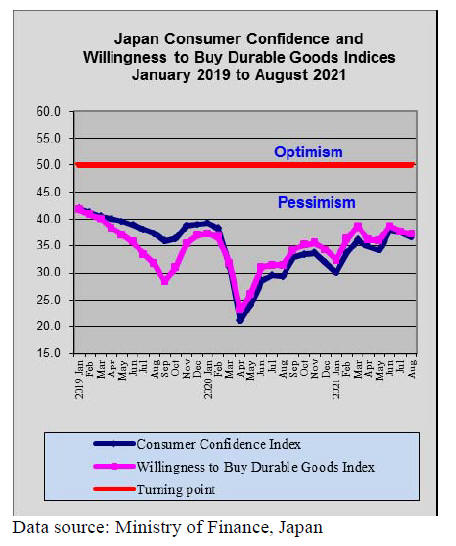
The August dip in the consumer confidence index was
anticipated as the virus situation and state of emergency
measures implemented in the country.
Private sector investment dips
Private sector machinery orders fell 1.5% in June from the
previous month, the first decline in four months but,
despite a serious surge in corona infections the
government remains optimistic on its recovery forecast.
The Cabinet Office maintained its assessment that
machinery orders, seen as a leading indicator of corporate
capital spending, are showing ¡°signs of picking up.¡± In
May, the office revised upward the evaluation for the first
time in five months.
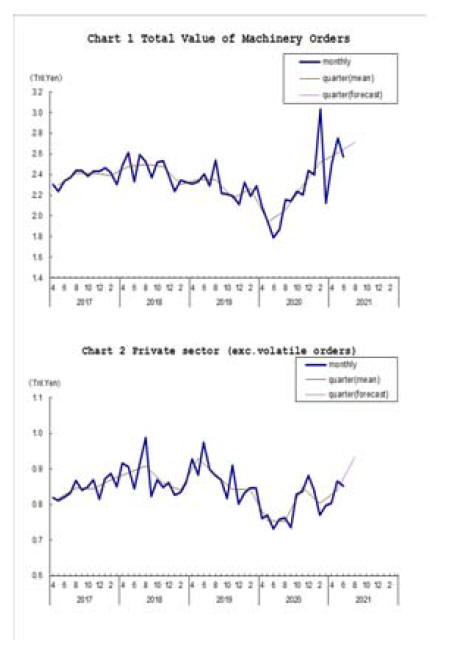
See:
https://www.esri.cao.go.jp/en/stat/juchu/2021/2106juchue.html
Yen exchange rate remain steady
The US dollar gained some strength in mid August
achieveing highs against most major currencies over
continued concerns about the Delta variant but the
advance was short lived and the US dollar/Yen exchange
rate fell back to the narrow 110 range it has maintained for
the past months.

Jump in wood product prices
Data from the Bank of Japan (BoJ) shows July wholesale
prices jumped almost 6% year on year, the fastest pace in
nearly 13 years driven higher by rising energy and
commodity prices.
The BoJ latest survey showed that petroleum and coal
product prices soared 39% from a year earlier and prices
for wood products surged 33% on supply shortages, in part
because of growing demand for new homes and
renovations. Such a steep rise, if prolonged, will inevitably
affect the cost of homes.
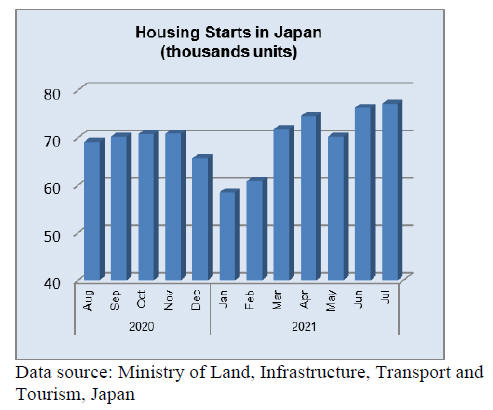
July 2021 housing starts were around 10% higher than
in
July 2020 but compared to June there was little growth.
Furniture imports exceed pre-pandemic level
Quite remarkably, Japan¡¯s imports of wooden office,
kichen and bedroom furniture in the first half of 2021 have
exceeded those in pre-pandemic 2019. For office and
kichen furniture the value of imports in 2020 were below
that of 2019 but again, remarkably, imports of wooden
bedroom furniture in 2020 were higher than in 2019 and in
2021 they were above the level seen in 2020.
The combined effect of adjusting home furnishing to adapt
to remote working and the effect of restricted travel and
curtailed holidays put extra cash into household budgets
some of which, it appears, was spent on furniture.
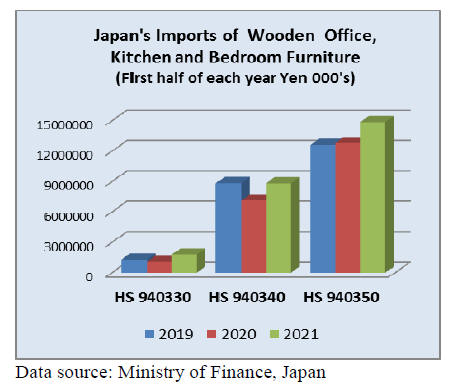
Office furniture imports (HS 940330)
Imports of wooden office furniture dipped slightly (-2%)
in June this year compared to May but compared to June
2020 they were over 70% higher.
The top shippers of wooden office furniture in June this
year were China and Poland, accounting for 80% of all
wooden office furniture imports in the month. Arrivals
from France which was in the top league in May were
down, accounting for just 6% of imports and a relative
new comer, Singapore, was the forth ranked shipper in
June.

Kitchen furniture imports (HS 940340)
After 2 months of decline Japan¡¯s imports of wooden
kitchen furniture picked up in June. Month on month the
value of June imports rose 17% and year on year there was
a 37% increase.
Over 90% of imports of wooden kitchen furniture were
from shippers in just 3 countries, the Philippines (48% of
imports), Vietnam (36%) and China (10%).
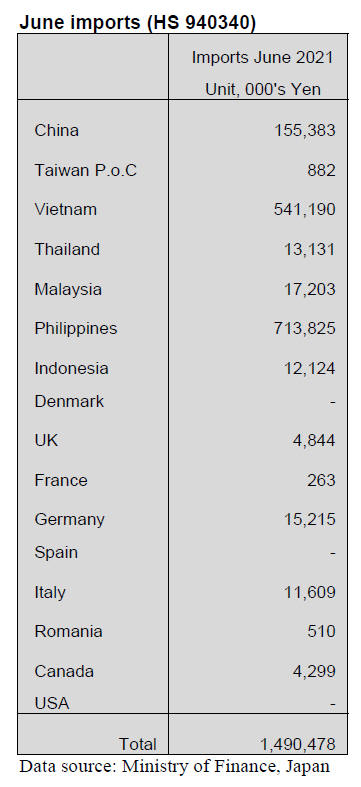
Bedroom furniture imports (HS 940350)
For 2 consecutive months the value of Japan¡¯s imports of
wooden bedroom furniture has remained at around the
same level and current imports are below the highs seen at
the beginning of the year. Never-the-less, June imports
were just under 10% higher than in June 2020.
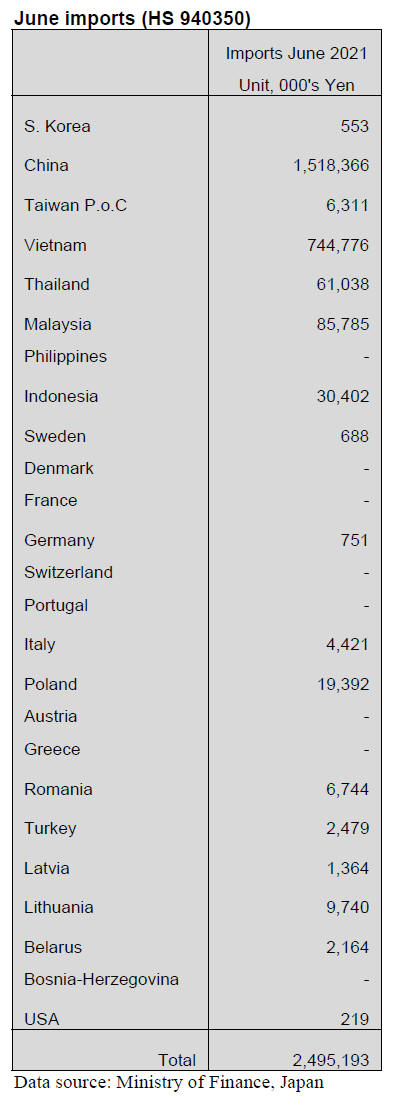
The main suppliers of wooden bedroom furniture to
Japan
in June were manufacturers in China and imports from
China accounted for over 60% of total June imports of
wooden bedroom furniture.
Shippers in Vietnam claimed the second spot accounting
for 30% of Japan¡¯s imports. Shippers in SE Asia captured
around 7% of market share with the main SE Asian
supplier being Malaysia followed by Indonesia and
Thailand.
Trade news from the Japan Lumber Reports (JLR)
The Japan Lumber Reports (JLR), a subscription trade
journal published every two weeks in English, is
generously allowing the ITTO Tropical Timber Market
Report to reproduce news on the Japanese market
precisely as it appears in the JLR.
For the JLR report please see:
https://jfpj.jp/japan_lumber_reports/
Domestic logs and lumber
Movement of domestic logs and lumber settled down and
is pausing since late July. Overheated market in the
Western Japan is easing down. Cypress log prices in the
Western Japan shot up to 50,000 yen in early July then this
was the peak and the prices slightly dropped in late July.
Heavy rain hit the Western Japan in August and log
production started slowing down. Slackening lumber
market should tighten again in late August with fear of
declining supply.
If the supply decreases in large scale, the market of both
logs and lumber may rebound again in September.
Reason of peaking off of domestic lumber prices is that
the imported materials have been increasing gradually
since last month so panic of supply shortage is easing.
South Sea log and products
In Malaysia, lockdown restriction is lifted but in Sarawak,
stricter measures are taken to stop spreading of COVID.
It is about time that log harvest should be active before
rainy season arrives but by short time office hours of
administration offices delays renewing of harvest permit
with labor shortage, log harvest is largely hampered.
Therefore, it is struggle to secure log supply for every
plywood mills.
With higher prices of laminated free board, supply of
Indonesian mercusii pine is unstable so the dealers
continue aggressive purchase of Chinese free board.
Production of mercusii pine lumber face difficult time to
increase because of log shortage and labor shortage by
COVID 19 then tight container space causes delay of
arrivals.
Chinese laminated free board is made of Russian red pine
and by export restrictions by the Russian government, the
prices are constantly increasing.
June plywood supply
Total plywood supply in June is 491,900 cbms, 19.7%
more than June 2020 and 7.4% more than May.
The volume of plywood in last year decreased a lot
because the domestic plywood production was reduced
nearly by 30%. Also the import plywood was less 200,000
cbms in 2020 which made the numbers of supply in this
year higher percentage than last year.
There is still not enough inventory because of a lively
demand even though the plywood manufacturing
companies are going into full commercial production.
The domestic softwood plywood¡¯s shipment is exceeded
production. The inventory of softwood plywood is 85,000
cbms and the structural softwood plywood is 74,500 cbms.
Especially, the inventory of structural softwood plywood
falls below 0.3 months.
It is very hard for some manufacturers to deliver goods by
deadline. The holiday in July and the periodical
inspections in August are the reasons which might cause
delays.
The number of imported plywood exceeded over 200,000
cbms for four months consecutively. Malaysian volume is
19.5% more than the same month of last year but
Indonesian volume is 8.3% less. Producing regions of
Malaysia and Indonesia continue suffering raging COVID
19, which hampers plywood manufacturing and log
production due to labor shortage so recovery of South Sea
hardwood plywood supply is very unlikely through the
year.
If this situation continues, the inventory of softwood
plywood will remain low in a second half of this year.
Import of European lumber
For the first half of this year, import of European lumber is
1,043,388 cbms, 18.2% less than the same period of last
year. This is four consecutive year¡¯s decline. The export
prices advanced and they are more than double of the
same period of last year.
By items, whitewood KD stud and taruki are 397,964
cbms, 11.8% less and semi-finished products like lamina
and genban are 645,517 cbms, 21.6% less. By source,
347,043 cbms from Finland, 14.3% less, 354,760 cbms
from Sweden, 19.7% less, 103,389 cbms from Austria,
15.0% less, 77,674 cbms from Rumania, 7.0% less, 22,270
cbms from Germany, 50.1% less.
Reason of decreased volume for Japan is that many
sawmills in Europe concentrate manufacturing dimension
lumber for the North American market. In central Europe,
supply of whitewood logs is very tight and many sawmills
struggle to secure enough logs.
Export prices of KD whitewood stud are Euro 350 and of
taruki are Euro 360 for January and February shipment,
about Euro 20 up then the prices advanced to Euro 500 for
May and June shipments. They soared to Euro 700-800 for
July and August shipments.
|